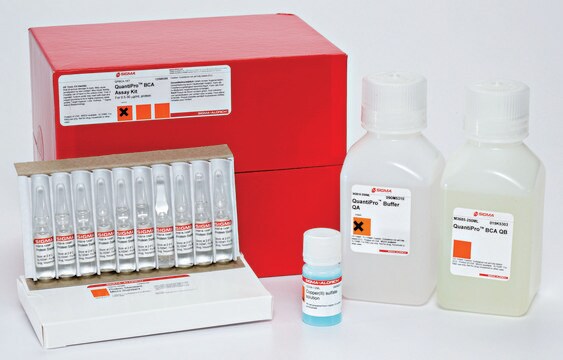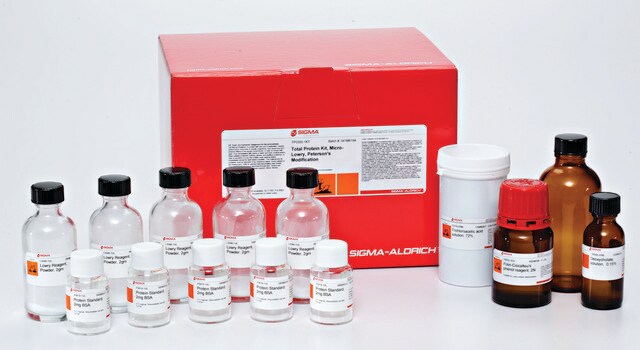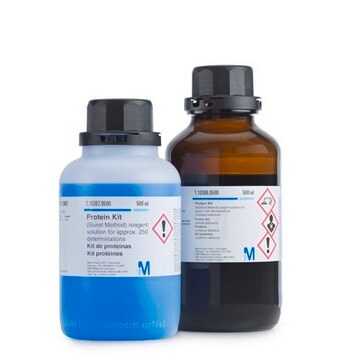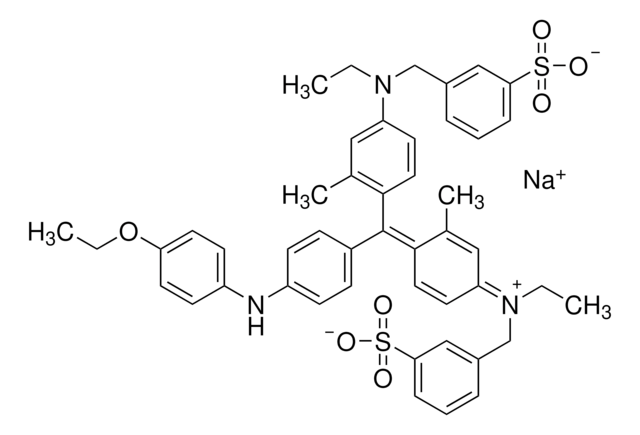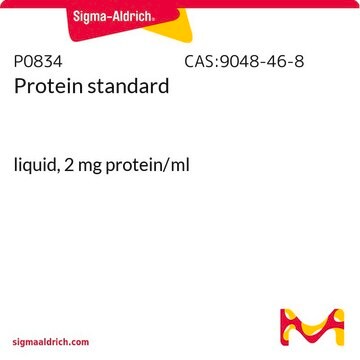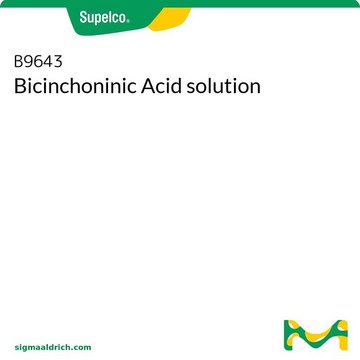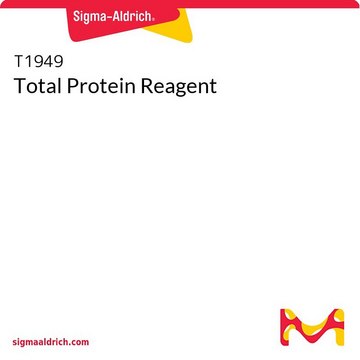Recommended Products
description
wavelength 595 nm
total test time 2 min
working reagent stability 18-26°C for 2 weeks
dynamic range 50 mg/dL 0.5 g/L
Quality Level
parameter
18-26 °C temperature
50 μL sample volume
storage temp.
2-8°C
General description
Protein determination is one of the most common operations performed in biochemical research. Total protein kit, micro provides a simple, rapid, and highly sensitive method requiring only 50 μL or less sample.
Application
Total protein kit, micro has been used to determine:
- total protein in the bacterial homogenate by Bradford method
- total protein content by the Bradford microassay from the tissue extracts
- serum total protein
- soluble protein content by the Bradford method from leaves
Biochem/physiol Actions
Total protein kit, micro can be used to determine the concentration of proteins in solution.
Suitability
Suitable for protein determination for samples of up to 0.5 mg/ml.
Principle
Brilliant blue G (Coomassie blue) reacts with protein in an acid-alcohol medium to form a blue-colored protein dye complex. The color, measured at 595 nm, is proportional to the protein concentration.
Testing Method
Colorimetric, Endpoint
Signal Word
Danger
Hazard Statements
Precautionary Statements
Hazard Classifications
Acute Tox. 4 Dermal - Acute Tox. 4 Inhalation - Acute Tox. 4 Oral - Aquatic Chronic 2 - Eye Dam. 1 - Flam. Liq. 3 - Met. Corr. 1 - Skin Corr. 1B - Skin Sens. 1 - STOT SE 1
Target Organs
Eyes,Central nervous system
Storage Class Code
3 - Flammable liquids
Flash Point(F)
132.8 °F
Flash Point(C)
56 °C
Choose from one of the most recent versions:
Already Own This Product?
Find documentation for the products that you have recently purchased in the Document Library.
Customers Also Viewed
Joshua M Halman et al.
Tree physiology, 33(11), 1242-1251 (2013-12-05)
Forests of northeastern North America have been exposed to anthropogenic acidic inputs for decades, resulting in altered cation relations and disruptions to associated physiological processes in multiple tree species, including sugar maple (Acer saccharum Marsh.). In the current study, the
Digital camera-based lipase biosensor for the determination of paraoxon
Pohanka M, et al.
Sensors and Actuators B, Chemical, 273, 610-615 (2018)
Differences in antioxidant mechanisms in grapevines subjected to drought and enhanced UV-B radiation.
Doupis G, et al.
Emirates Journal of Food and Agriculture, 24(6) (2012)
Jason G Lieberthal et al.
The Journal of rheumatology, 40(5), 674-683 (2013-04-03)
Glomerulonephritis (GN) is common in antineutrophil cytoplasmic antibody (ANCA)-associated vasculitis (AAV), but tools for early detection of renal involvement are imperfect. We investigated 4 urinary proteins as markers of active renal AAV: alpha-1 acid glycoprotein (AGP), kidney injury molecule-1 (KIM-1)
Elizabeth Gray et al.
Journal of neuropathology and experimental neurology, 67(9), 888-899 (2008-08-22)
Matrix metalloproteinases (MMPs) degrade extracellular matrix; MMP activity, particularly of MMP-9, is elevated in the white matter in multiple sclerosis (MS) patients. The cerebral cortical extracellular matrix includes perineuronal nets (PNs) that surround parvalbumin-positive neurons (PV-positive neurons) and are important
Our team of scientists has experience in all areas of research including Life Science, Material Science, Chemical Synthesis, Chromatography, Analytical and many others.
Contact Technical Service


